Battleship: Creating The FX
Battleship computer graphics supervisor Willi Geiger on why the aliens were actually American football players, reinventing water, sinking a ship in one two-minute shots and loads, loads more. Plus some great FX images
Battleship computer graphics supervisor Willi Geiger on why the aliens were actually American football players, reinventing water, sinking a ship in one two-minute shots and loads, loads more.
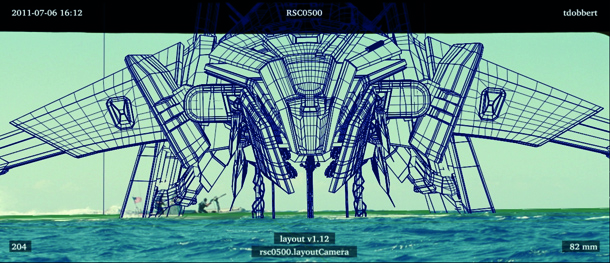
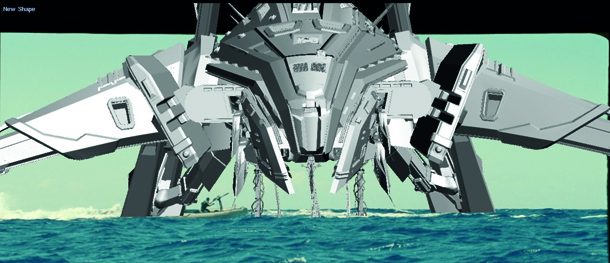
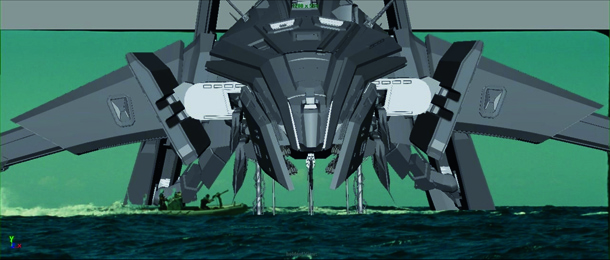
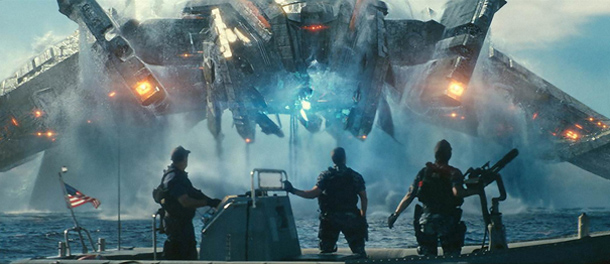
These days, when you look at a blockbuster like Battleship there are normally a million names credited with handling the special effects in one way or another. You are credit as “Computer Graphics Supervisor”. What precisely does that entail?
“I supervised the team of lighting and effects artists, which meant that I was looking after about 20 or 30 people. I was also on the movie about a year before production began and during that time I was working with our research and development team to bring our technology up to the next level.”
Didn’t you have to completely redesign how water was created digitally?
“We did. And remember this is you know, starting from a fluid simulation system that had won an Academy Award (for Pirates Of The Caribbean ). So you know it’s not like our water system wasn’t already world class. But when we looked at the breakdown for this movie, there were two things that kind of stood out on Battleship . One was the sheer number of shots: about 1,000 in total. That isn’t, in itself, mind-boggling by modern standards, but there were about 400 digital water shots and even more importantly, there were about 100 shots that we would normally categorise as ‘hero shots’.
“We normally use the cream of the effects artists at ILM to do hero shots – there are just a handful of people who can do those big hero shots – and typically we let them go for weeks or even months on a single shot. That works fine if you have say five or ten, or even maybe 20 of those hero shots. But, like I say, on this movie we knew there were like 100 of these shots and we just didn’t have enough of those experts to do it that way. The only other alternative was to take our whole effects pipeline and make it faster and easier to use so that we could not only turn the shots around faster, but we could do them with the full pool of artists and not just relying on those just two or three super experienced and competent effects artists.”
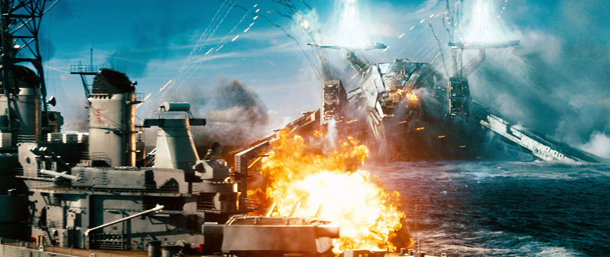
Is it correct that on shot took a year to create in itself?
Get sneak previews, exclusive competitions and details of special events each month!
“There was one particular shot that when the ship John Paul Jones is sunk. It’s a 3,000 frame shot with no cuts, so over two minutes of action. Just a few different plates were shot of the principal actors against green screen and then the whole thing has to be completely constructed digitally. The whole sinking of the ship, all of the digital pyrotechnic work, the mast where it breaks and crashes down through the ship and the whole sinking was all digital. I can honestly say that’s one of the most complicated shots ILM has ever done. If anyone ever asks you to do a 3,000 frame shot full of effects with no cuts I’d advise you to say no. That was not an easy shot to do.
“I have to admit there’s one other slightly frustrating bit from our point of view. After developing the whole thing as a single continuous shot, right at the last minute the director did actually insert a couple of cut-aways of the actors to get emotional reaction. But it might be worth when it comes out on DVD going back and taking a good look at the shot; you’ll see that, except for those two cut aways, its just one great big long tracking camera shot.”
Do you think most people realise what what an achievement that is?
“I watched it and I thought. ‘How many people are going to quite know what went into this?’ But that’s part of the trick isn’t it? We put so much detail and integration into shots that people are never going to explicitly notice. There are little details like the water lapping up to bits of debris and creating little splashes. Or the way that the explosions light up the ship and the water and making sure all the wind directions are consistent and all those little things that makes it real. Nobody notices those things individually. But what they do notice is when we get it wrong.
“And you know, people can step through it frame-by-frame if they want. So there really is nowhere to hide any more.”
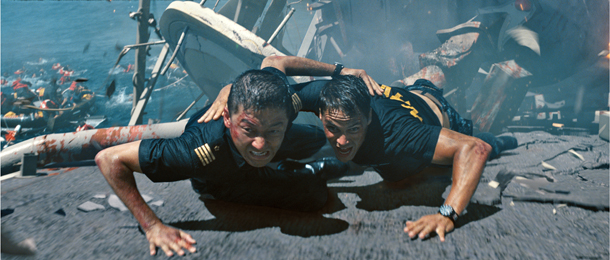
“I’m glad you noticed that! That was a very important part of the discussions we had with the director, Peter Berg. It’s nice that you say it gave our work time to breathe a bit because that’s nice for us. That wasn’t the main motivation though; the main thing was to convey scale. You have to let things happen slowly. Things that huge – especially out in water – they don’t move that quickly.
“Of course, that’s at odds with it being a Hollywood movie where you need it to be dynamic and action-packed and fast. And that’s always a real tricky line to walk, to be able to keep up the excitement and intensity levels but at the same time give enough time for things to evolve so you don’t blow scale.
“I won’t call out any specific examples but I have seen movies where the director has pushed too much towards speed and frenetic action. Suddenly things don’t look big and they don’t look heavy anymore; it looks cartoony”
Another of the big FX moments in the movie was the handbreak turn…
“Believe it or not I’m told that is a real manoeuvre. The ships can actually do that. They can drop anchor and turn round. Now I’m guessing it doesn’t happen anything near as quickly as it happens in the movie, of course. We’re making a Hollywood movie, we take a few liberties. But apparently they really can do that. So yeah that was a neat little plot device. I think that was a neat thing that Peter came up with because it was able to weave together a few different elements. From an emotional and character development point of view it kind of showed how this young inexperienced rough-around-the-edges naval officer learning how to become a tactician and to think in terms of a battle. But of course it also gave us a way that we could make sense of the fact that this mothballed battleship defeats this huge powerful alien ship.”
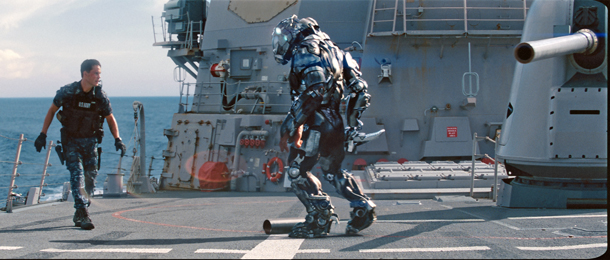
Were you at involved with the creation of the aliens?
“Yeah very much ILM played a big part. We had concept artists both on the studio side and at ILM working on them. Without doubt the driving force behind the design of the aliens was that Peter did not want the aliens to be horrific. He didn’t want them to be monsters. So he didn’t want that typical kind of horrifying, icky, slimy, scary look. He wanted the aliens to feel like the navy, like battle-hardened warriors.
“That was the very important thing, so we talked a lot about referencing old sea dogs from naval movies, like Gregory Peck and so on. Peter also referenced football players. He’s a huge America football fan. So a lot of the time he’d say, ‘Okay, this alien has to look like such and such American football player.’
“And one thing you notice about the aliens is that they’re not all gleaming and shiny; they’re actually dirty. Their armour is pitted and scratched; they themselves have scars. And that’s all about trying to get across, visually, this back story that they’ve done this before, that they are battle-hardened. Peter wanted them to have this kind of nobility, so as far as possible we’ve tried to put that into the animation, that they were real thinking characters with pride and real emotions. Not just monsters coming to kill everybody.”
I interviewed Peter Berg earlier in the year and he was animated – doing explosion noises and waving his arms around to describe things. Is that what he was like to work with?
“Absolutely. Peter was crazy. There so much of his personal character that manifests itself in the movie. The fact that the movie is so over-the-top and unrelenting and non-stop and muscular and aggressive – that’s Peter; that came directly from his character. That’s what he’s like to work with. He’s insane. You know what he’s like? He’s like the shredders in the movie. You know those things that fly and spin through everything and tear it apart and leave a trail of destruction behind – that‘s what Peter’s like. He’s very physical. He’ll literally jab his finger in your chest he’ll get right up in your face and shout. Working with Peter is not for the faint-hearted.”
[VAMS id="XovECm51a753d" bc="1551046192001" url="battleship-peter-berg-interview-XovECm51a753d"]
What are working on now?
“I’m now working on The Lone Ranger , a Gore Verbinski project. It’s a remake of the old TV show with Johnny Depp as Tonto as Armie Hammer as The Lone Ranger. That promises to be right at the opposite end of the spectrum to Battleship . Whereas Battleship was this huge bombastic fantastical thing, The Lone Ranger is much more about control and subtly and getting all the details right. So very different but I’m very excited. Gore Verbinski is great director to work with; he has a very keen visual sense and a huge knowledge of film that he loves to share with the people working with him.”
Did you work with him on the Pirates Of The Caribbean ?
“I worked with Gore on mainly on the second movie, Dead Man’s Chest , and then also on Rango . I was the effect lead on the final sequence of Rango. So I’ve worked with him before and it’s always a pleasure. I love his movies and I’m very excited about this project.”
Battleship is available on 20 August on Blu-Ray™ Ultraviolet™, DVD and digital download.
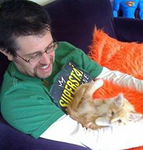
Dave is a TV and film journalist who specializes in the science fiction and fantasy genres. He's written books about film posters and post-apocalypses, alongside writing for SFX Magazine for many years.


